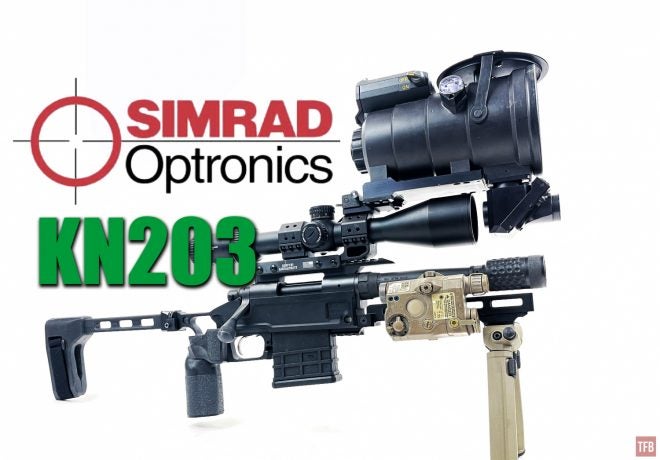Welcome back you nocturnal enthusiasts to another Friday Night Lights. Today we take a look at the Norwegian Simrad KN203. It is a night vision clip-on for weapon use. Friday Night Lights is sponsored by ATN Corp, manufacturers of night vision and thermal optics like the THOR LT. As with all of our sponsored series, Friday Night Lights will continue to bring you unbiased news and reviews from a variety of companies.
Night Vision Clip-On Articles @TFB:
- Friday Night Lights: Magnum Universal Night Sight (MUNS) PVS-27
- FRIDAY NIGHT LIGHTS: Meopta Meonight CNVD (Clip-On Night Vision Device)
- Review: Knights Armament Co. AN/PVS30 Clip-On Night Vision
Norwegian SIMRAD KN203

If you recall we looked at another SIMRAD night vision device last year. The SIMRAD GN1 is a cool piece of kit. It is low profile and aesthetically looks awesome. You can see it in the photo above next to the KN203. As mentioned in my GN1 article, SIMRAD has changed a couple hands. It was briefly under the VINGHØG umbrella before it was acquired by Rheinmetall in Germany.
The KN203 is a rather interesting design for a night vision clip-on. Night vision clip-ons are designed to allow shooters to use their day scopes. The device is mounted in front of the day scope to augment the scope’s ability to see at night. Most clip-on systems that we see are mounted linearly. The whole device sits in front of the scope. The PVS-27 and PVS-30 are the most common night vision clip-ons here in the US. The CNVD-LR/PVS-24 is a smaller but similar concept. You mount them on a Picatinny rail so they sit in front of your day scope. Another common method we see in thermal clip-ons, especially the European and Chinese thermals, they attach to the objective bell of your day scope but you still have the body of the clip-on directly in front of the scope’s objective lens. This is not the case with the KN203. It is almost like a giant COTI however instead of projecting thermal information, it projects a night vision image into the scope objective lens.
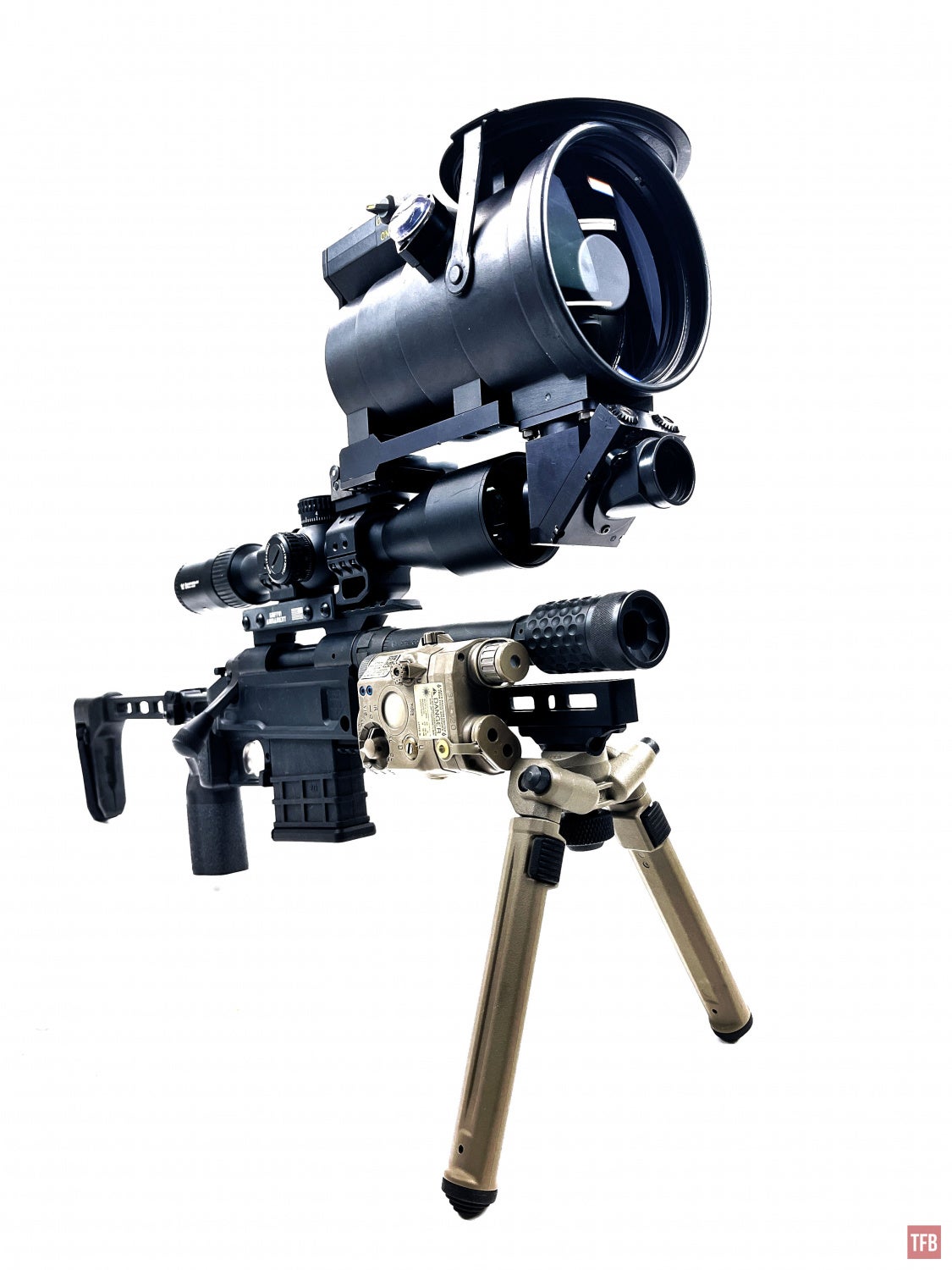
There are some pros and cons to this design. One of the pros is that you can attach the KN203 to a weapon that does not have a forward Picatinny rail. See my Pork Sword above for an extreme example. Traditional rifles, like sniper rifles, may have a chassis but few of them have a full-length rail let alone a night vision hood/bridge for attaching a clip-on.
But why not just mount the clip-on to the objective?
Mounting a large device to the objective lens is not ideal. Clip-ons that attach to an objective lens are typically small and lightweight. The KN203 weighs over 4 lbs.
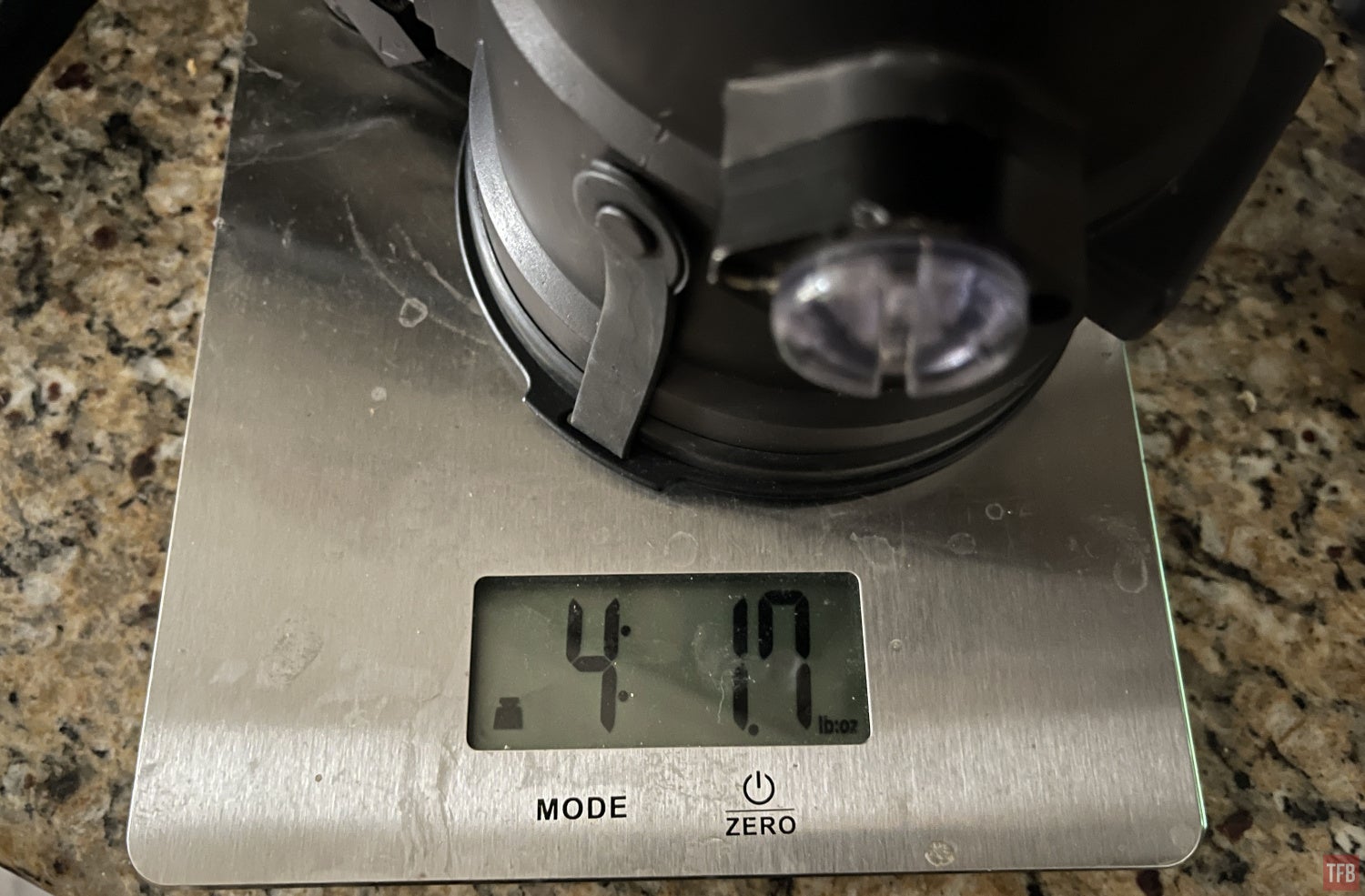
There are other benefits to the KN203 design. With a traditional linear clip-on, your day scope is blocked from seeing visible light unless you remove the clip-on. Not the case with the KN203. It has a window to look through and you can continue to use your day scope even with the clip-on attached.
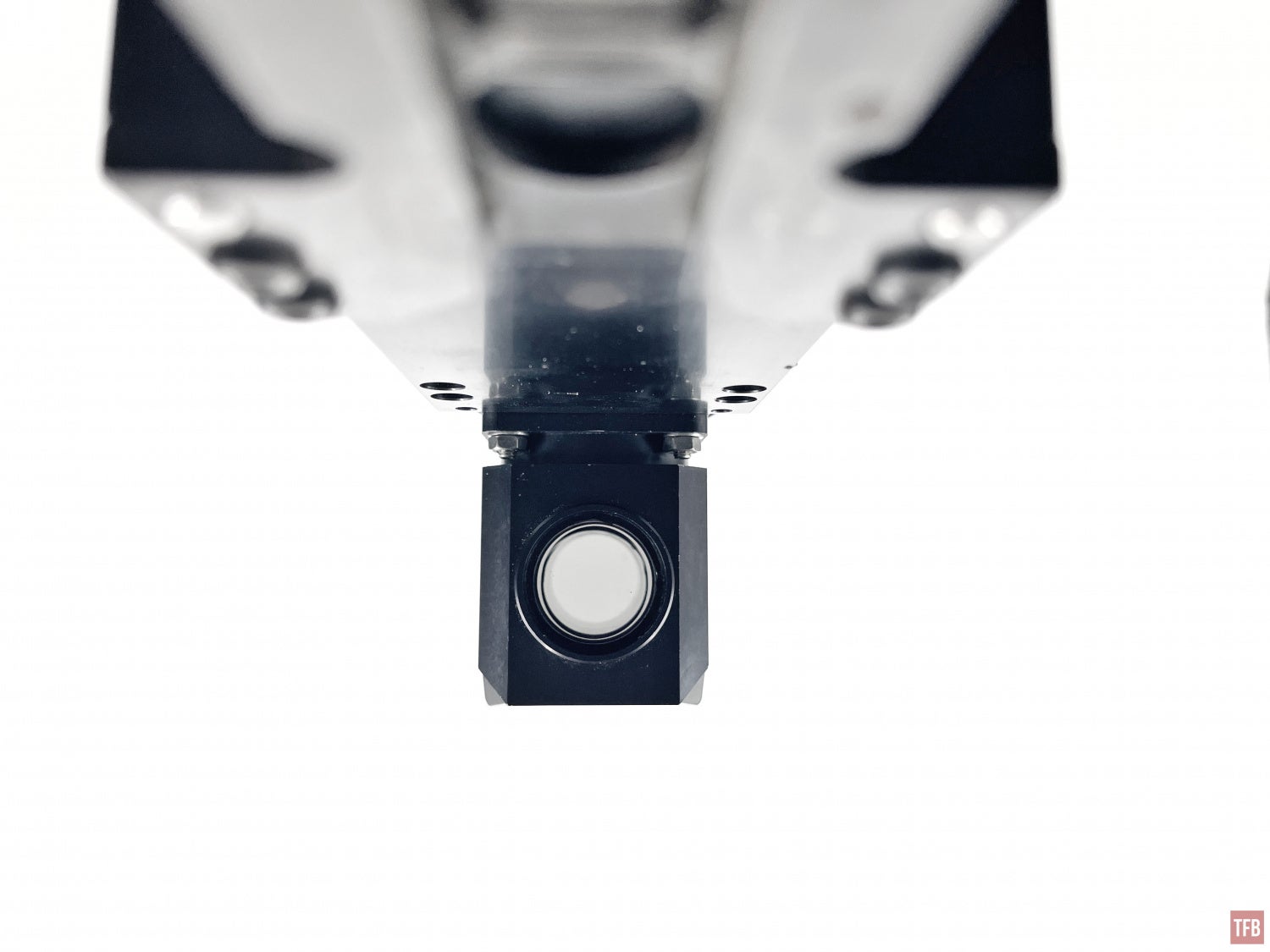
There is a trade-off of course. One of them is the prism/beamsplitter that projects the night vision image. good night vision clip-ons are collimated optically so that POA is not shifted. With the KN203 you have to adjust the beamsplitter. You can see the two adjustment screws below.
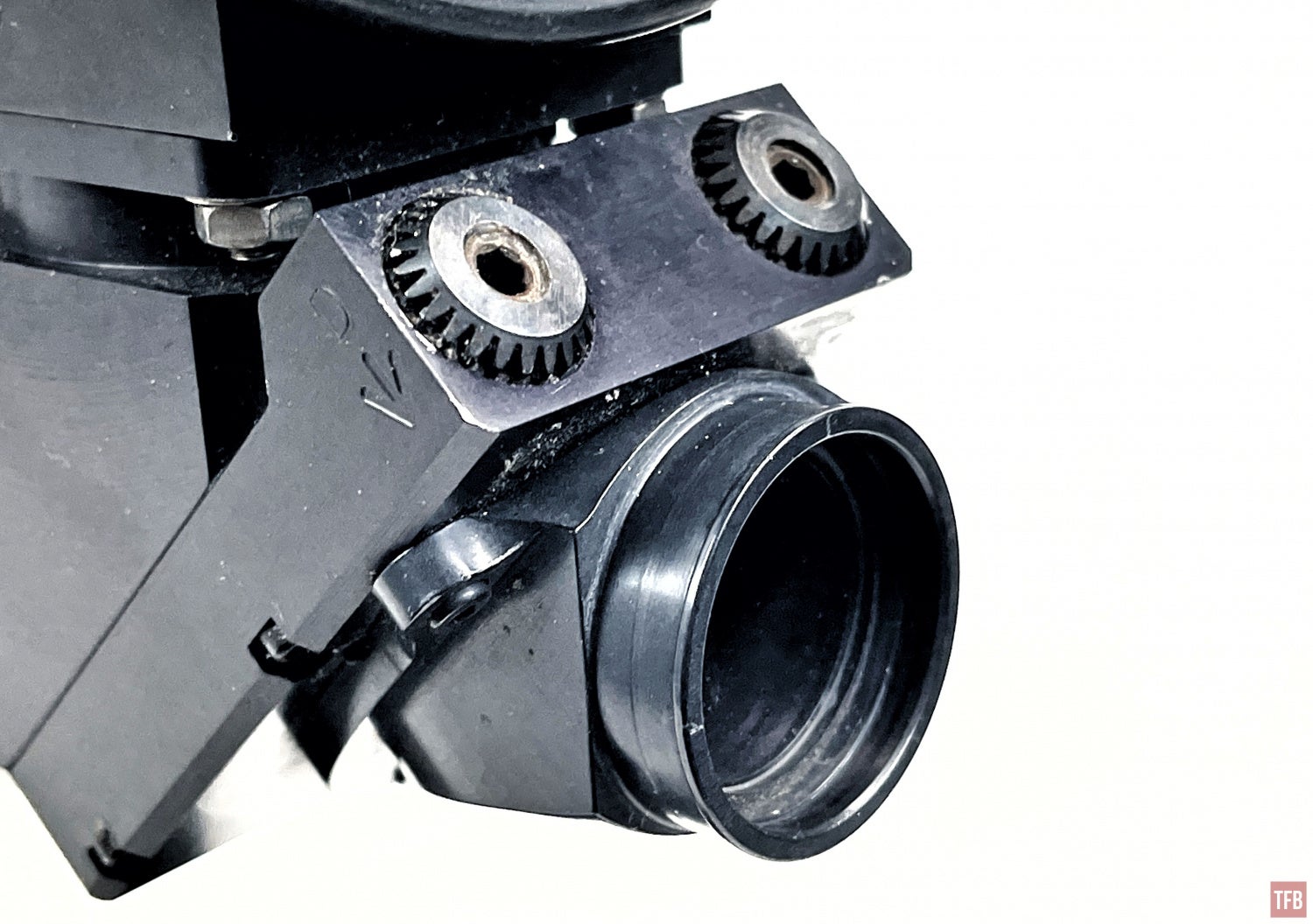
These adjust the image elevation and windage. According to the SIMRAD manual, these adjustments are approximately 1/2 MOA. They recommend a parallel zero. See the photo from the manual below.
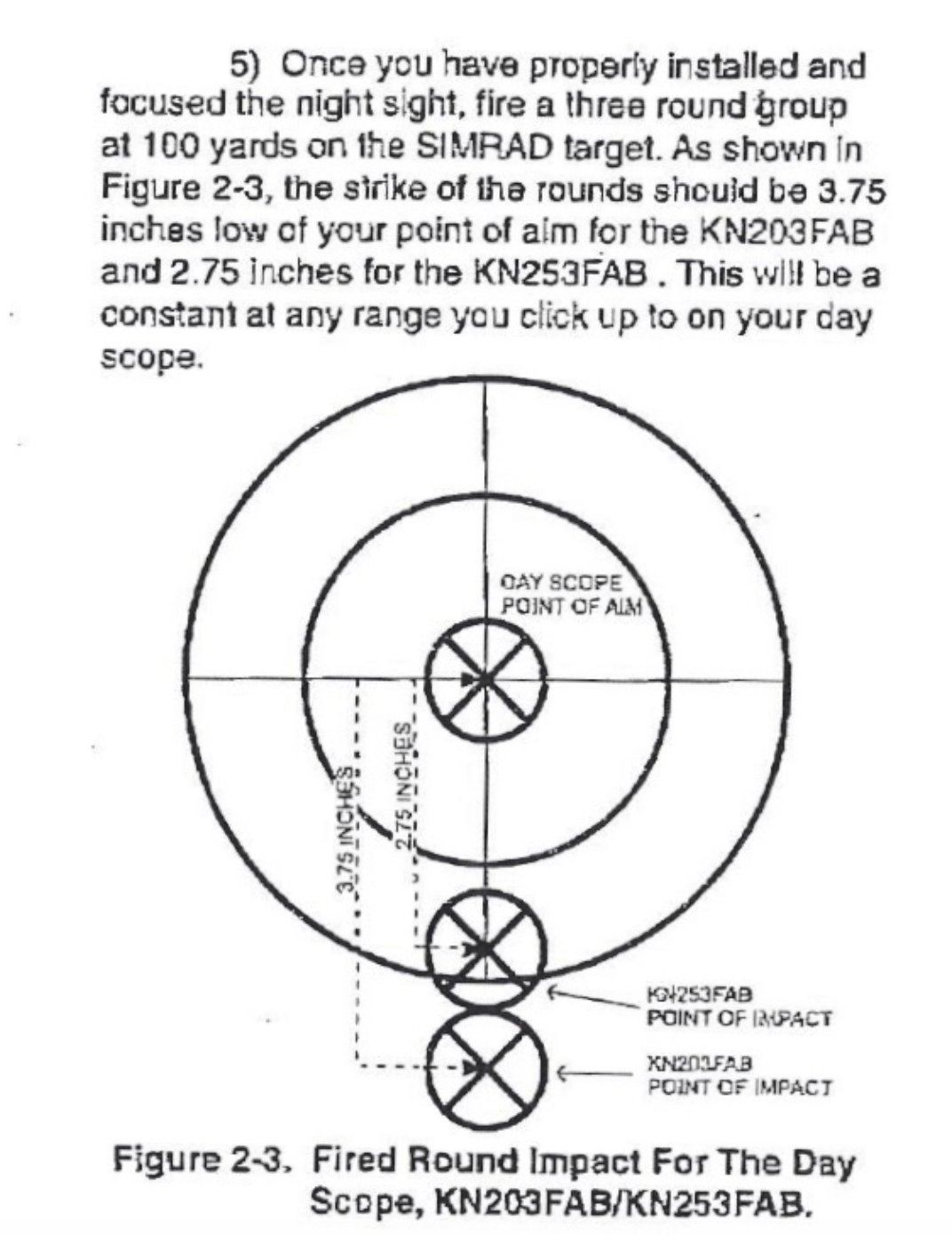
I found a simple way to adjust the KN203 beamsplitter. I mount a visible laser to my gun and zero it to my day scope at 100 yards. When I mount the KN203, the image will shift the POA of the laser in relation to my scope. But I know the laser is zeroed to my scope, so the shift is due to the clip-on. I then adjust the beamsplitter to make the laser image move to my scope reticle.
The other issue with the KN203 is how you mount it to the scope. It uses a proprietary plate design that mounts to your scope rings. I only know of three companies that make SIMRAD compatible mounts for rings: Spuhr, Griffin Armament and Badger Ordnance. There might be more but these are the three I found. I went with the Griffin Armament SPRM mount. It has some issues such as the mounting plate is not centered in any way. It is just a smooth plate bolted to the top of the scope rings. Spuhr uses a series of circular indentations so their attachments cannot shift or pivot.

The bottom of the KN203 has a large clamp that grabs onto the rail.
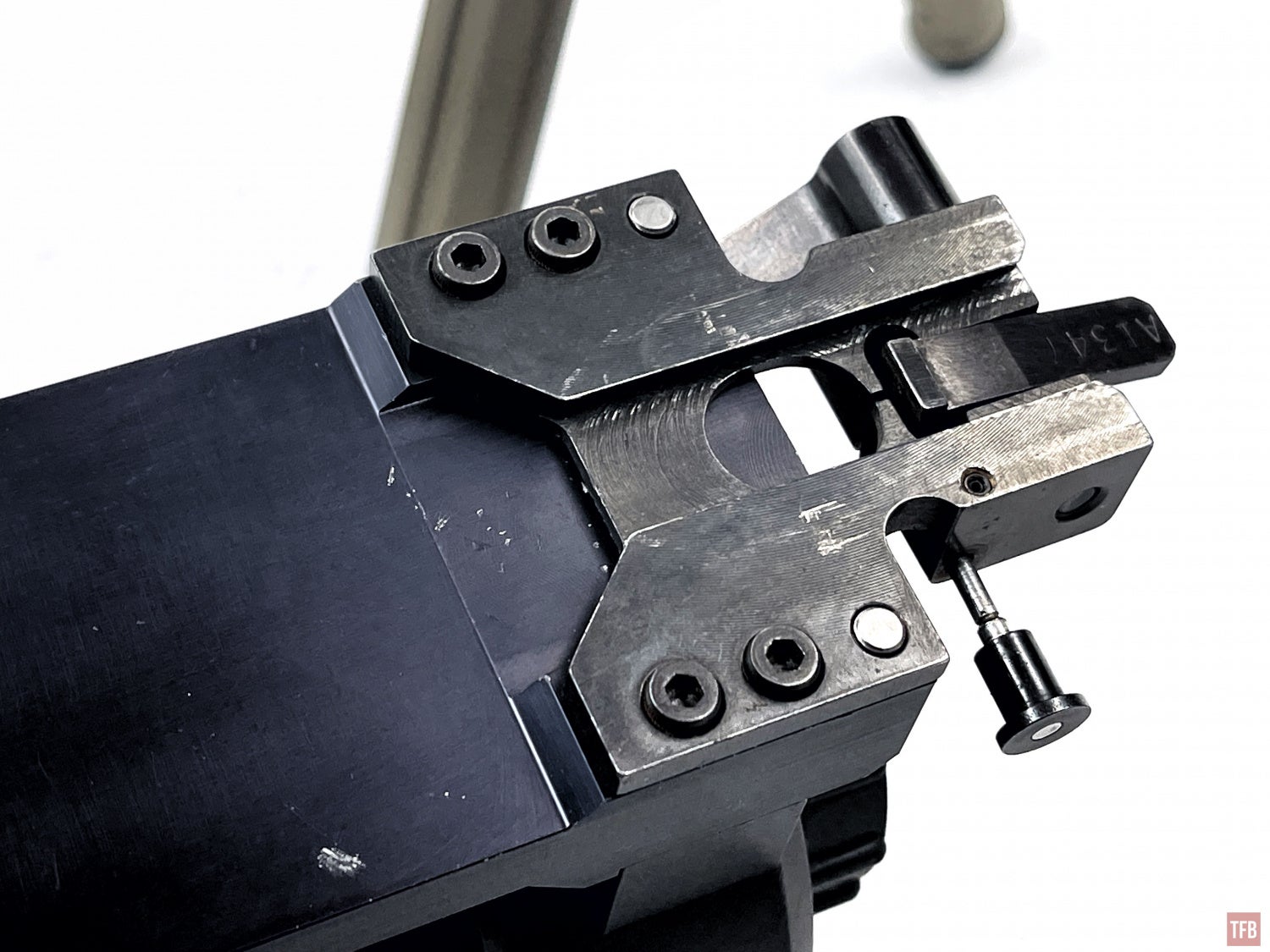
The mount is a bit convoluted. There are three things to manipulate when you want to mount or dismount the clip-on. There is a tightening throw lever, lock-out pin and a sprung lever.
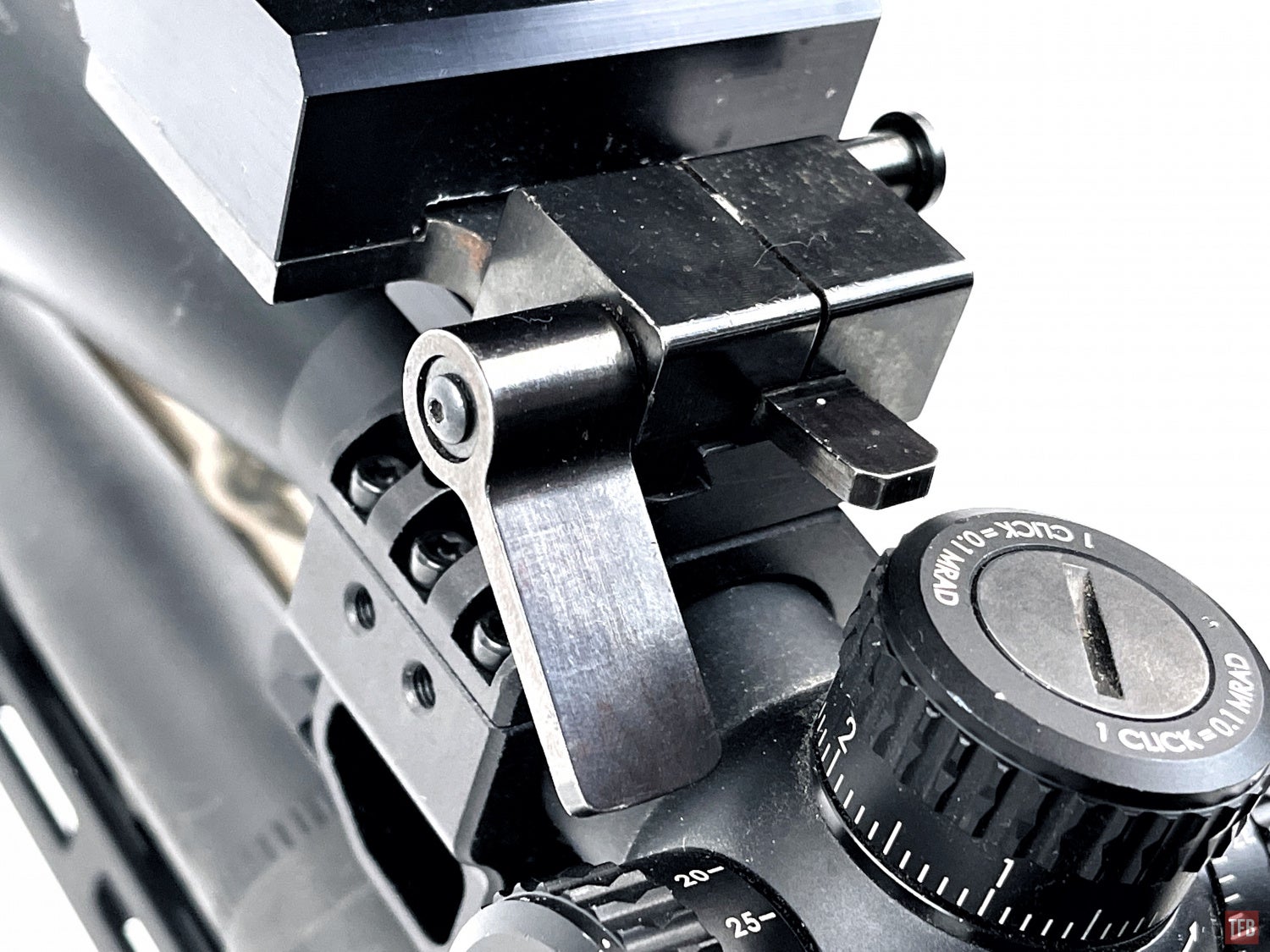
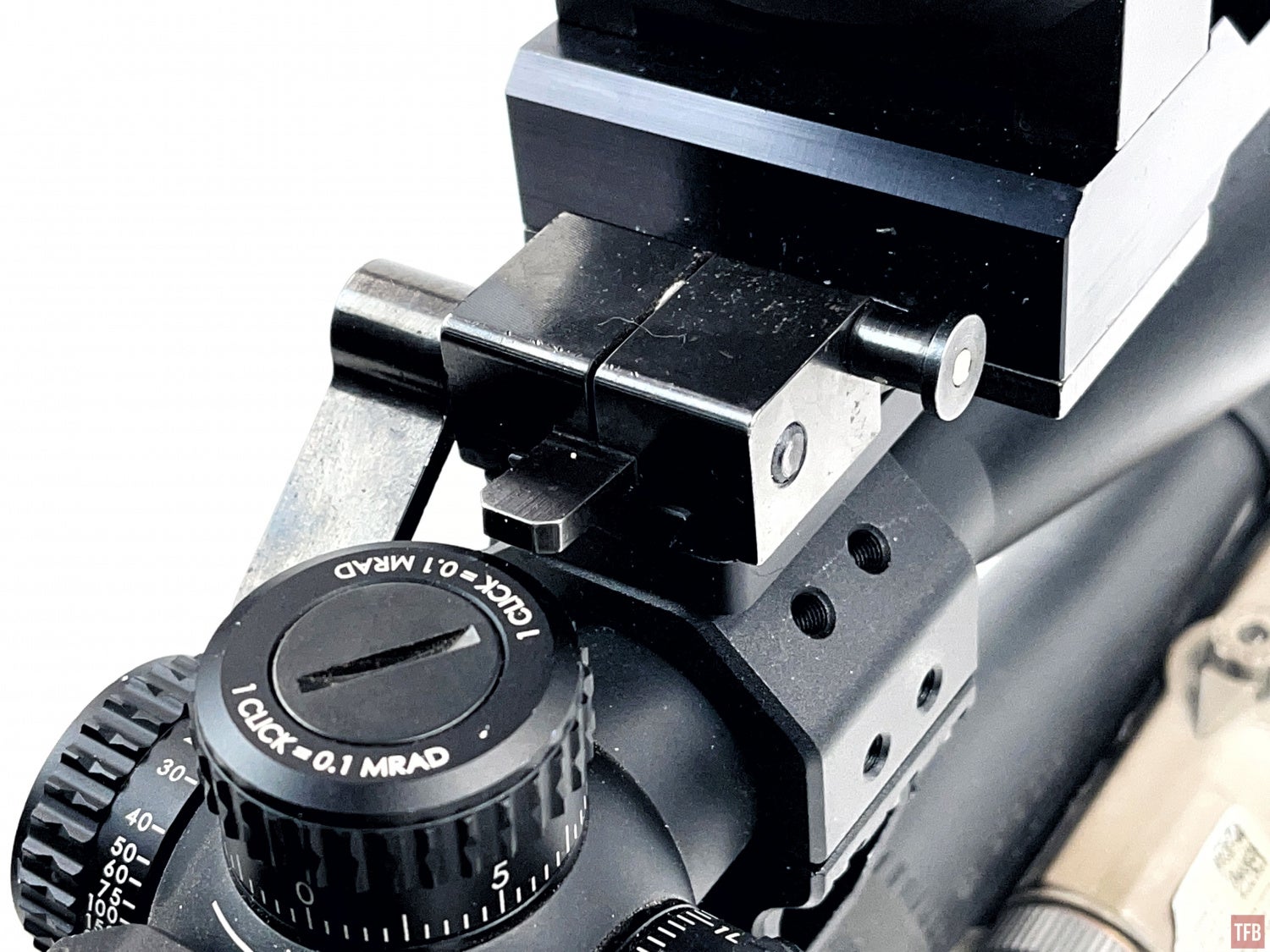
You need to rotate the tension lever all the way forward. Then pull the lock-out pin. This unit’s pin is rather tight so when you think it is all the way out, it isn’t and you need to pull it out more. Then you press the rear lever tab down to clear the slots in the rail and now you can slide the KN203 off the rail.

KN203 Controls
This KN203 seems to be an older model but I was unable to find any definitive information online. This one is powered by 2x C-Cell batteries. Some of my older night vision scopes are similarly powered. One benefit to using C-Cell batteries is that the capacity is larger which could equate to a possible 4x more runtime. According to the digital copy of the manual, the KN203 has an 80-hour runtime off 2x AA batteries. If my estimate is correct, this unit could run constantly for 320 hours or just over 13 days before needing to change out batteries.
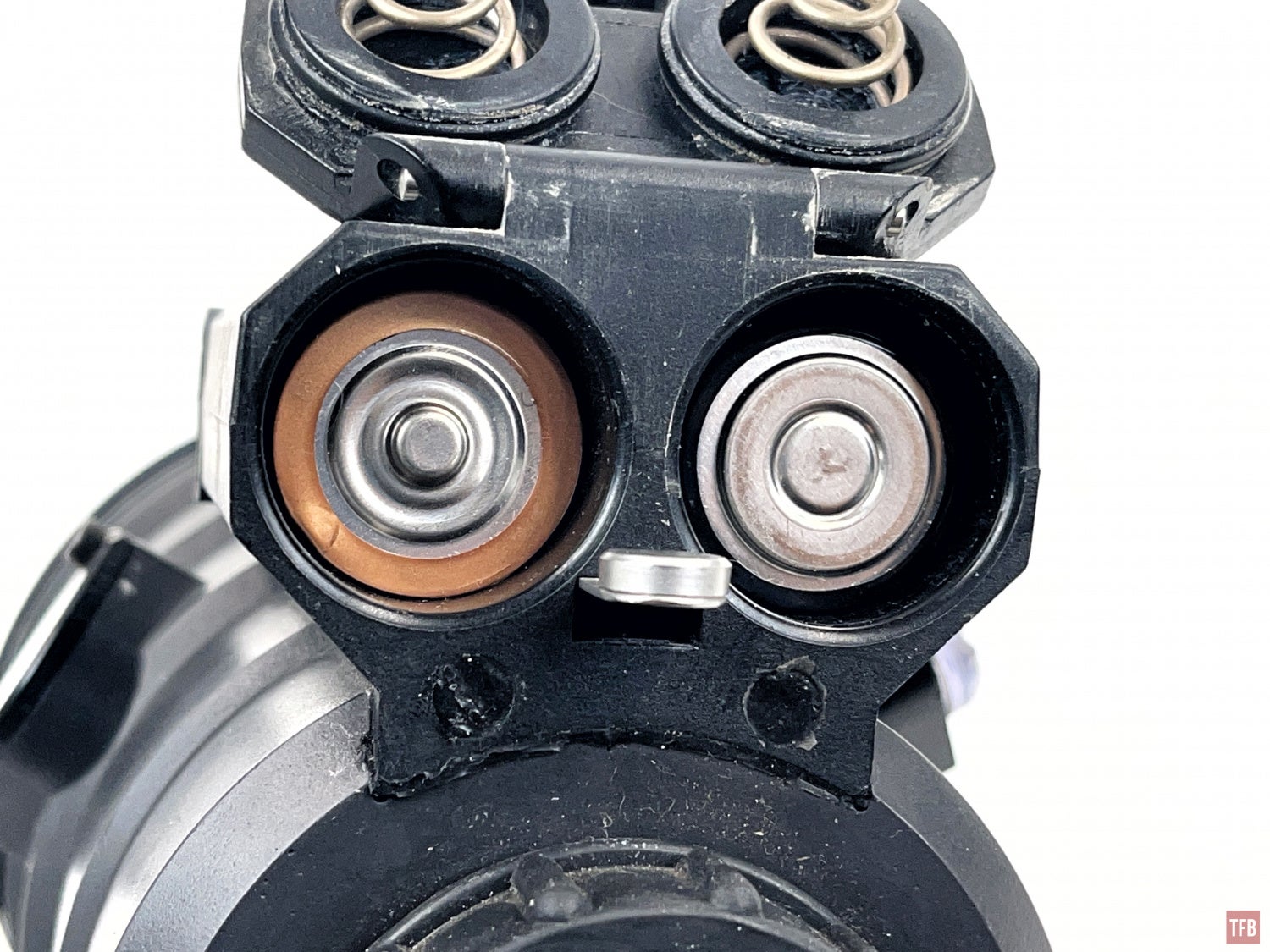
This unit came with C to AA conversion spacers so you can power it with 2x AA batteries.
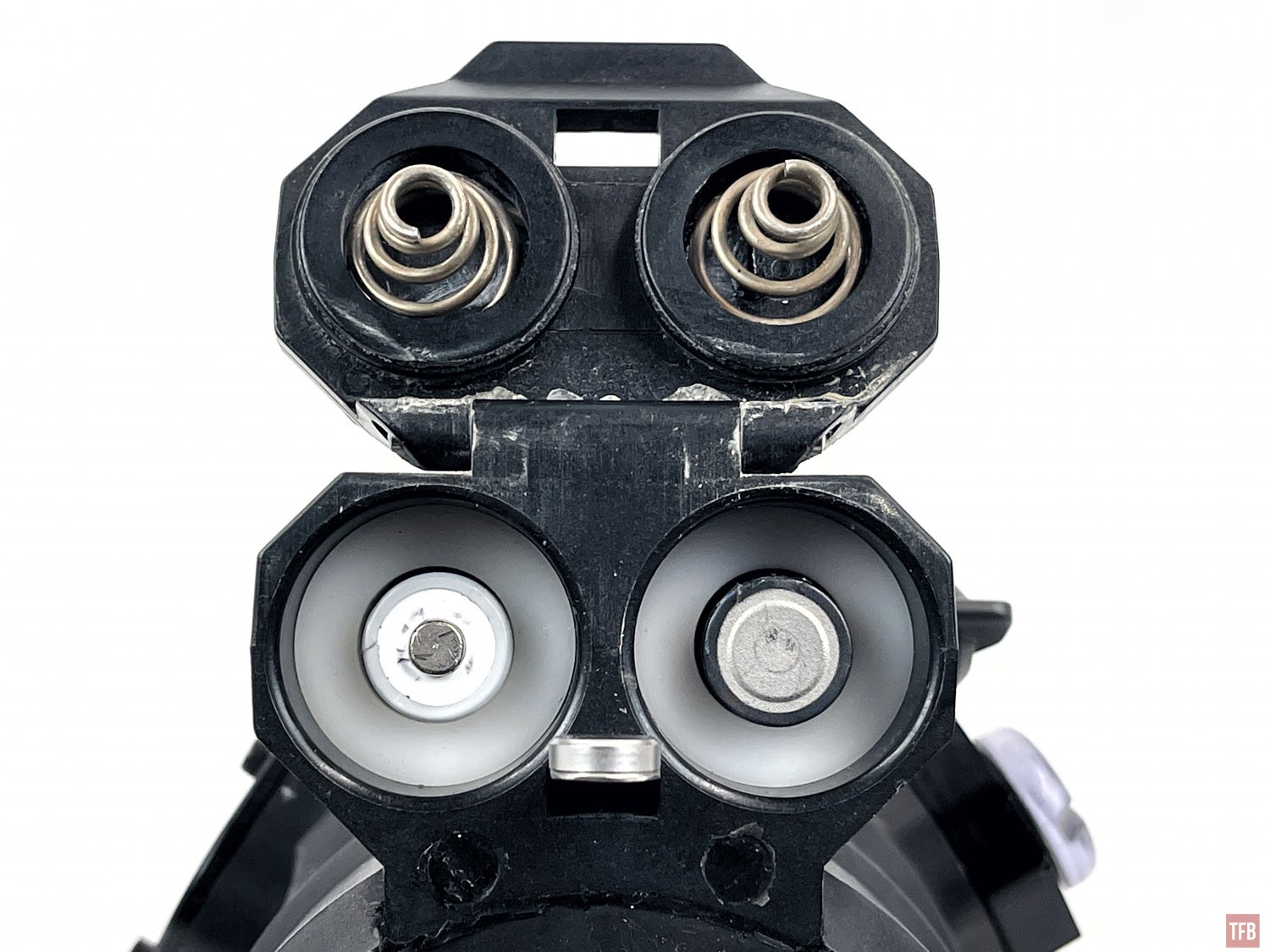
The power switch is on the right side of the battery compartment. Just below and forwards is something SIMRAD seems to have for their night vision devices. It is a desiccant compartment. Even the GN1 has something similar.
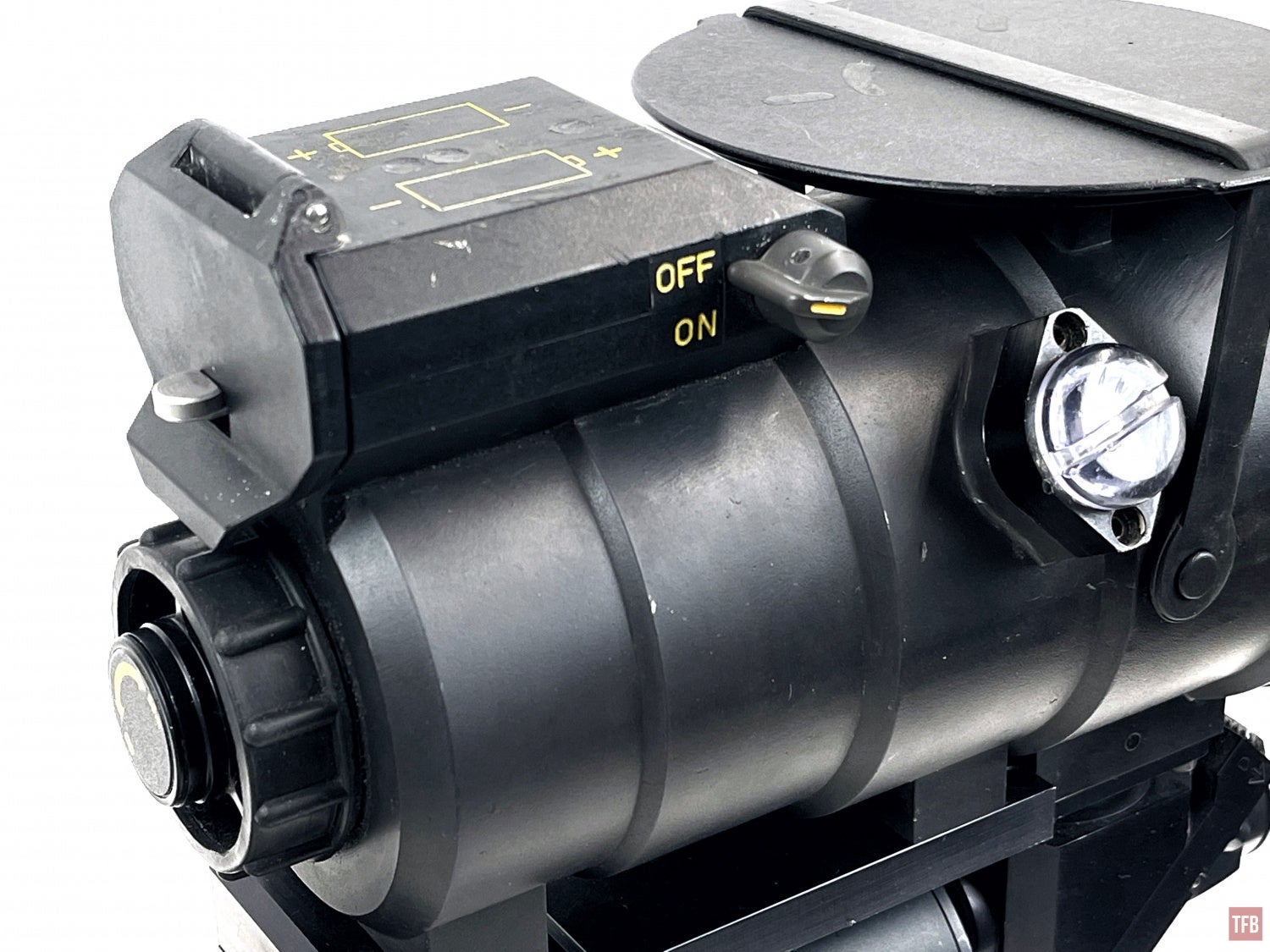
At the back of the KN203 housing is a large dial for adjusting the focus of the lens.

Newer versions of the KN203 have similar designs but there are some changes.
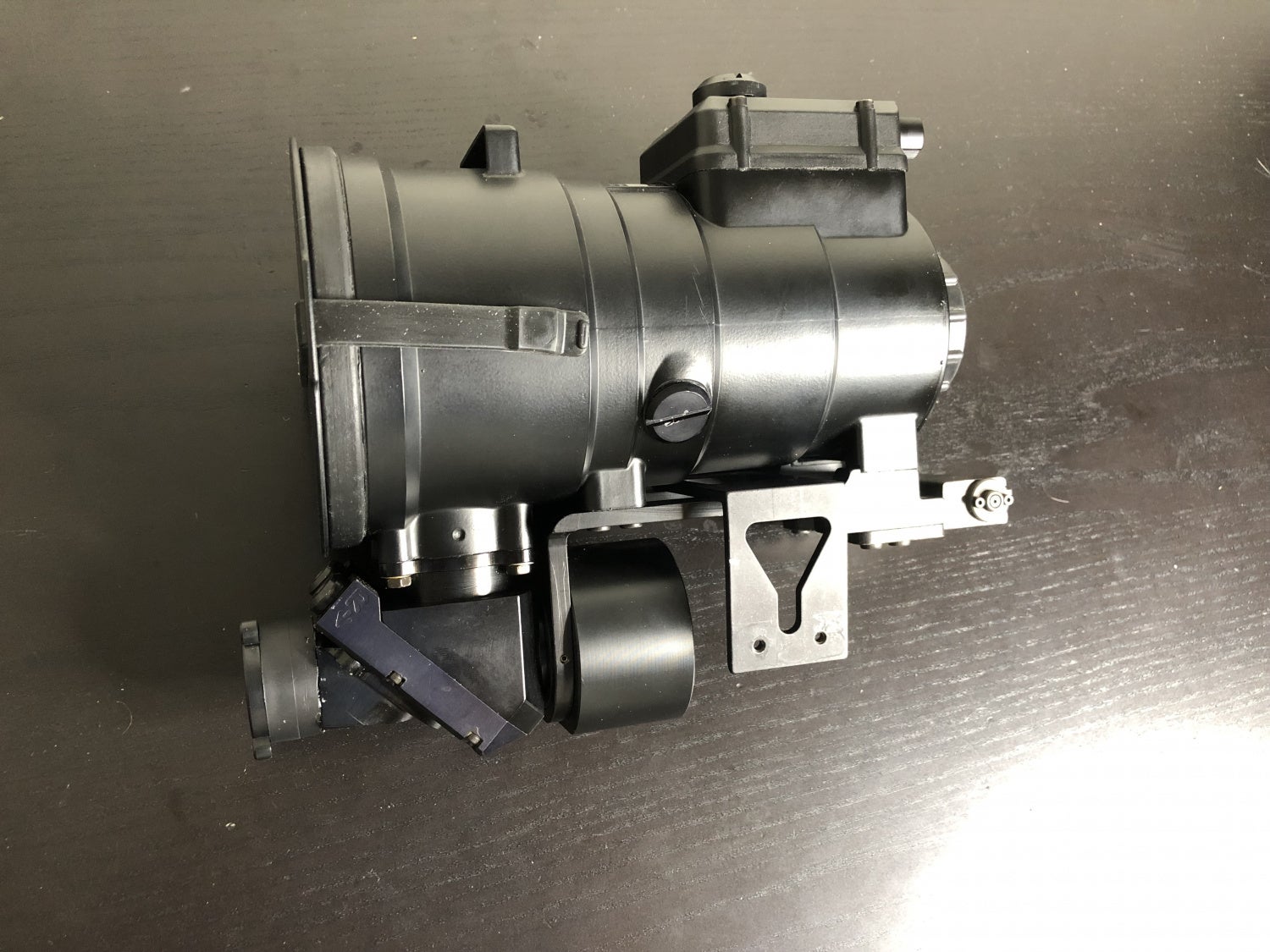
The battery compartment has been redesigned to utilize 2x AA batteries and the power switch is relocated to the back of the housing. Also, the power switch can adjust the manual gain. My KN203 does not have manual gain adjustment.

Does Size Matter?
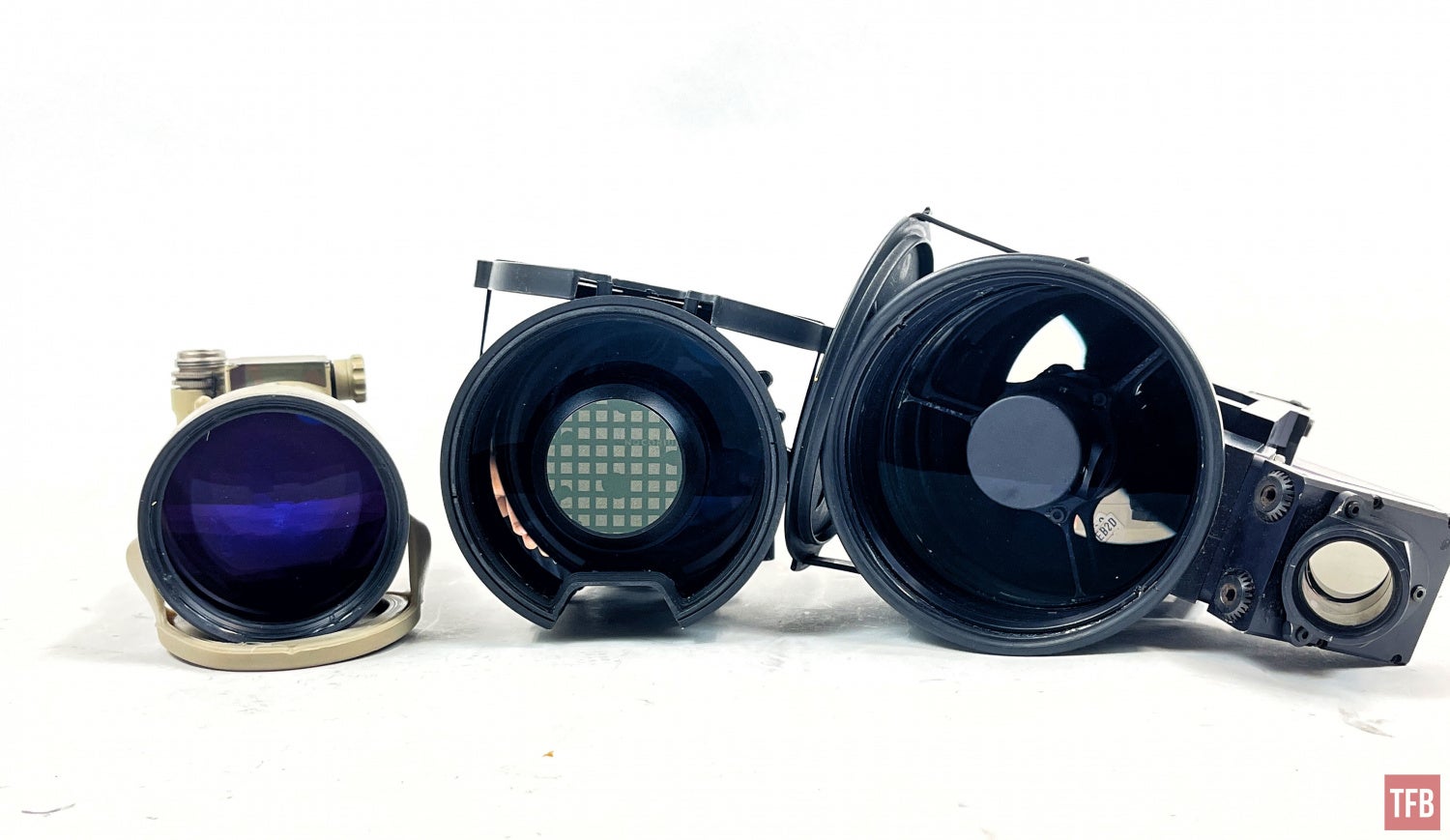
L-R: PVS-30, PVS-27, KN203
I have heard the KN203 surpasses the PVS-30 and PVS-27 since it had a larger objective lens letting in a lot more light. Below are real quick and dirty measurements of the objective lenses.
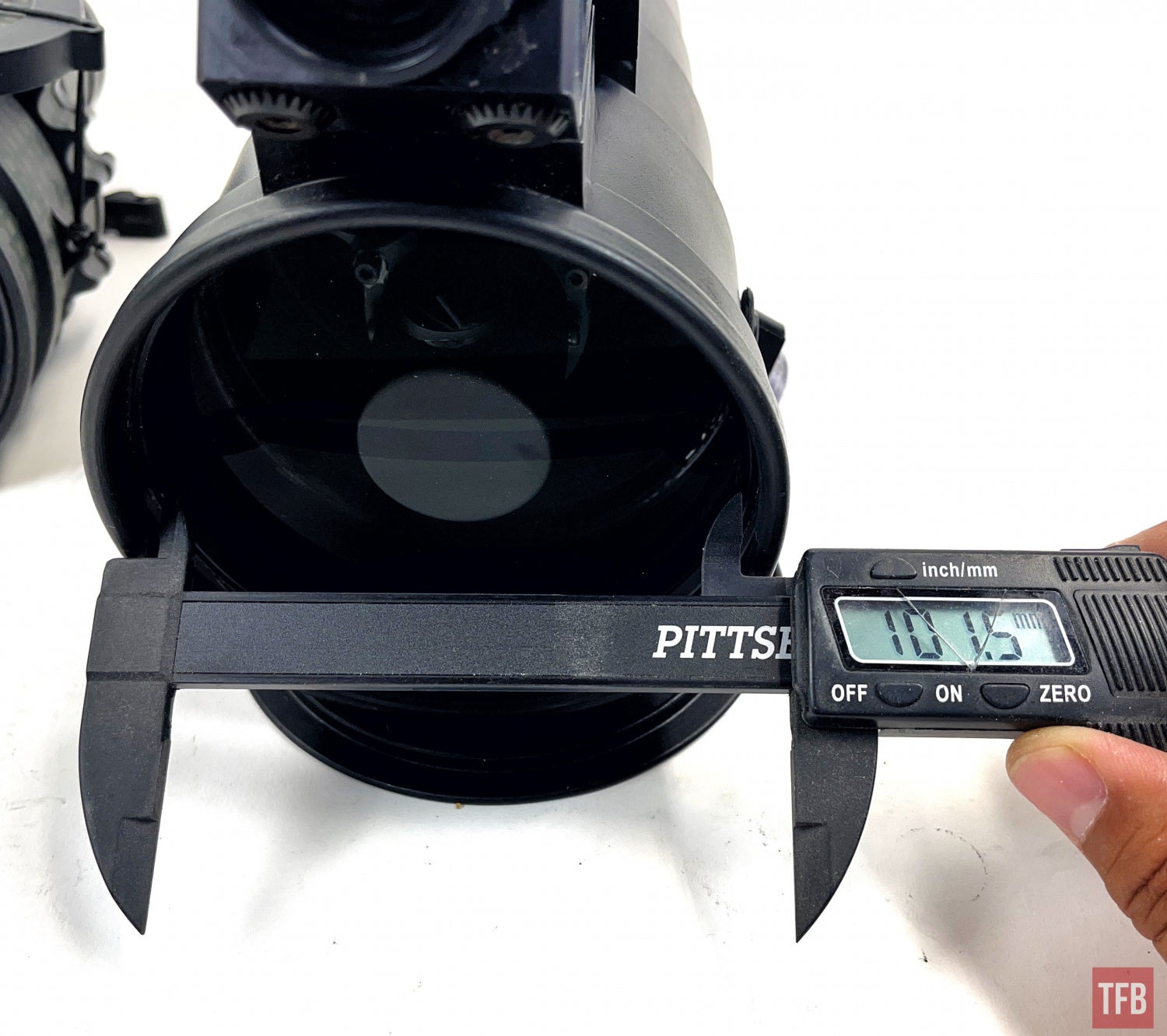
Simrad KN203

PVS-27
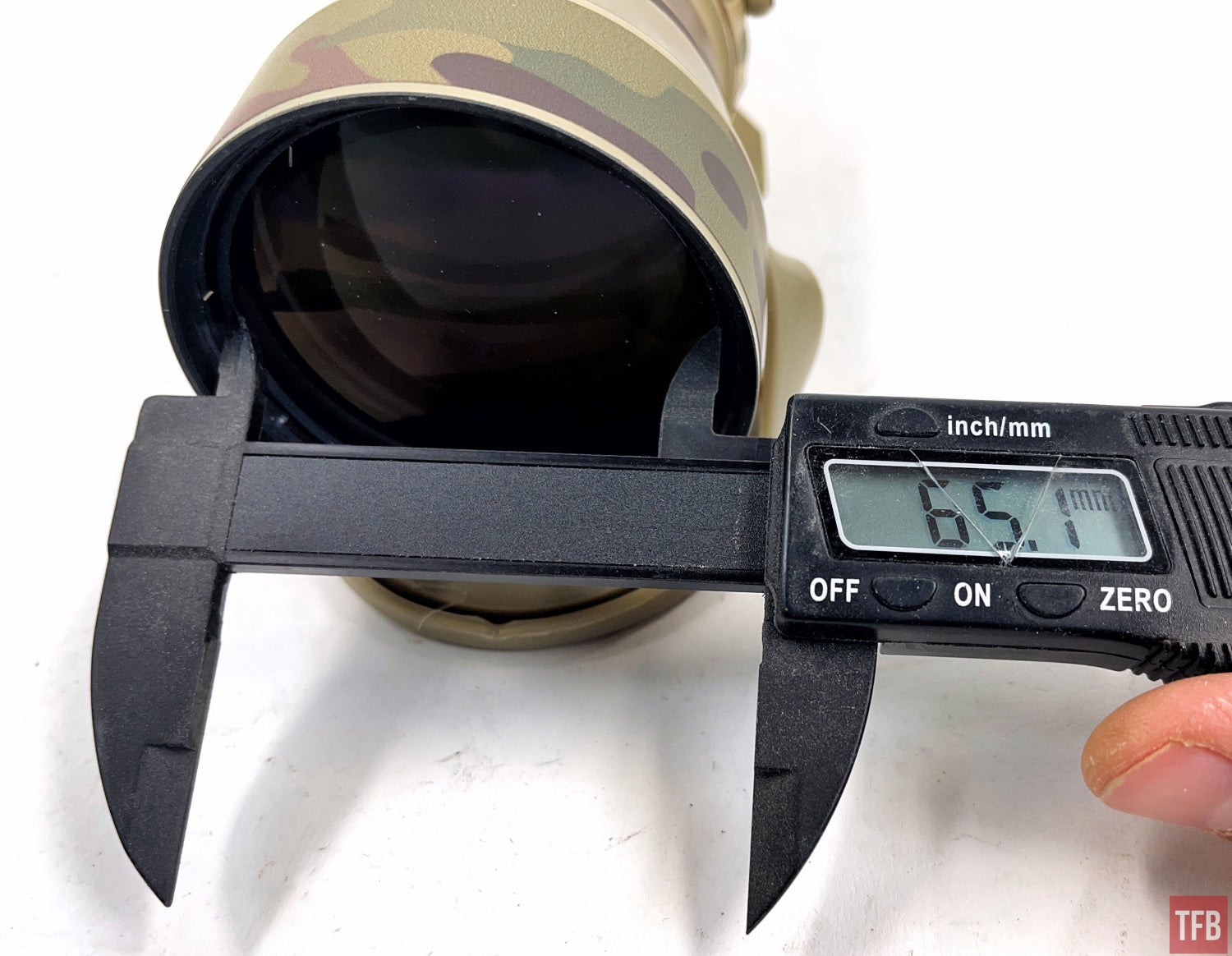
PVS-30
However, I did not find the KN203 to be better. While it certainly has a bigger objective lens, the limiting factor is the image intensifier inside. I do not know where or when this particular unit was manufactured. Did it come built from Norway and then imported in? If so that might explain the lower than expected performance.
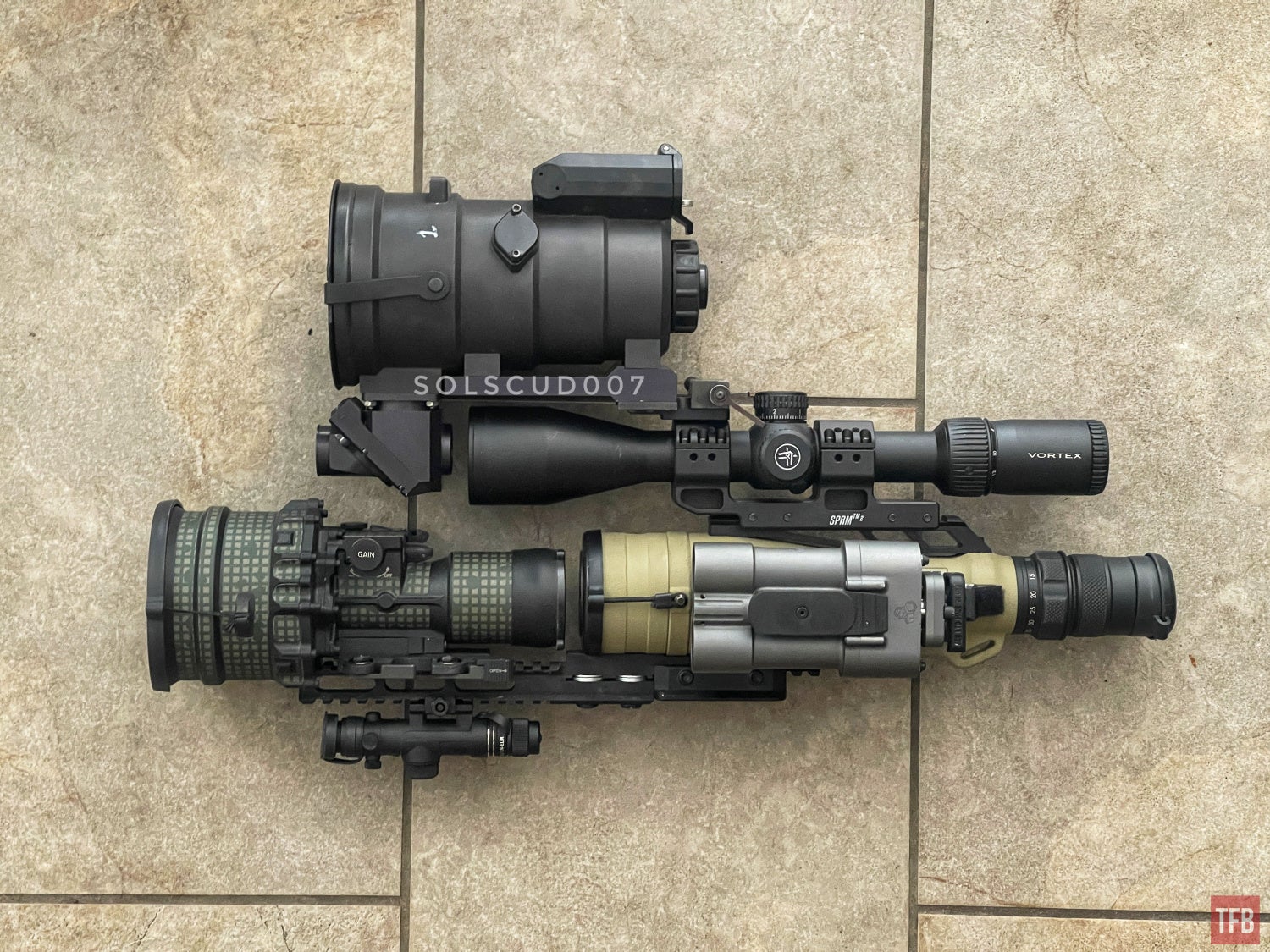
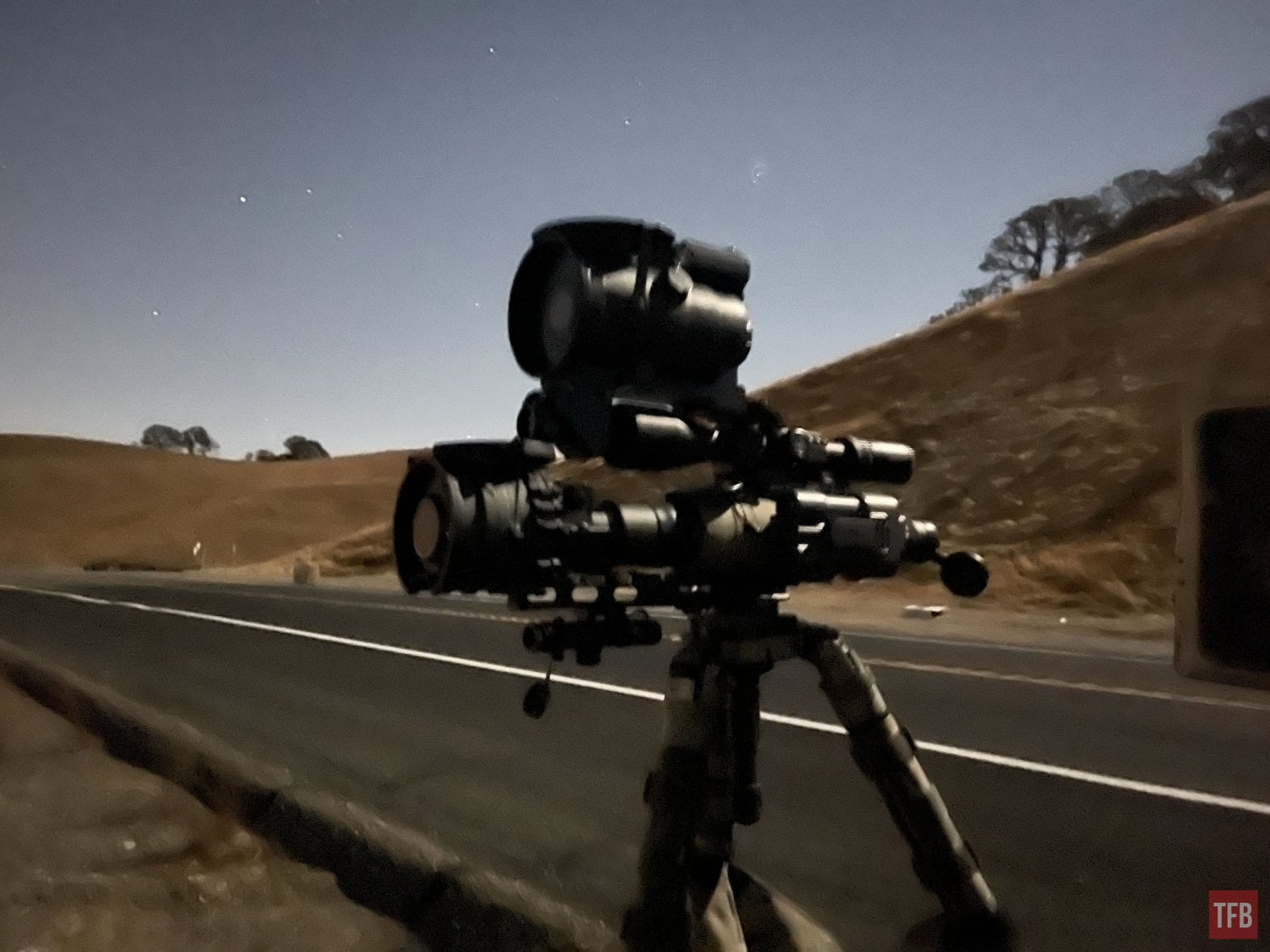
Please excuse the poor image below. I had mounted my Vortex Diamondback Tactical scope on top of my Bushnell Elite LMSS spotting scope so I could more easily directly compare both the KN203 and my PVS-27. The image below was taken through the Vortex at 8x magnification using my iPhone handheld. I could not use my normal phone holding rig on the Bushnell LMSS rails. The image is not this blurry when you look through the scope with your naked eye, but it is indicative of how the color and brightness of the image are. The bright spot is my Luna Optics ELIR laser illuminator.
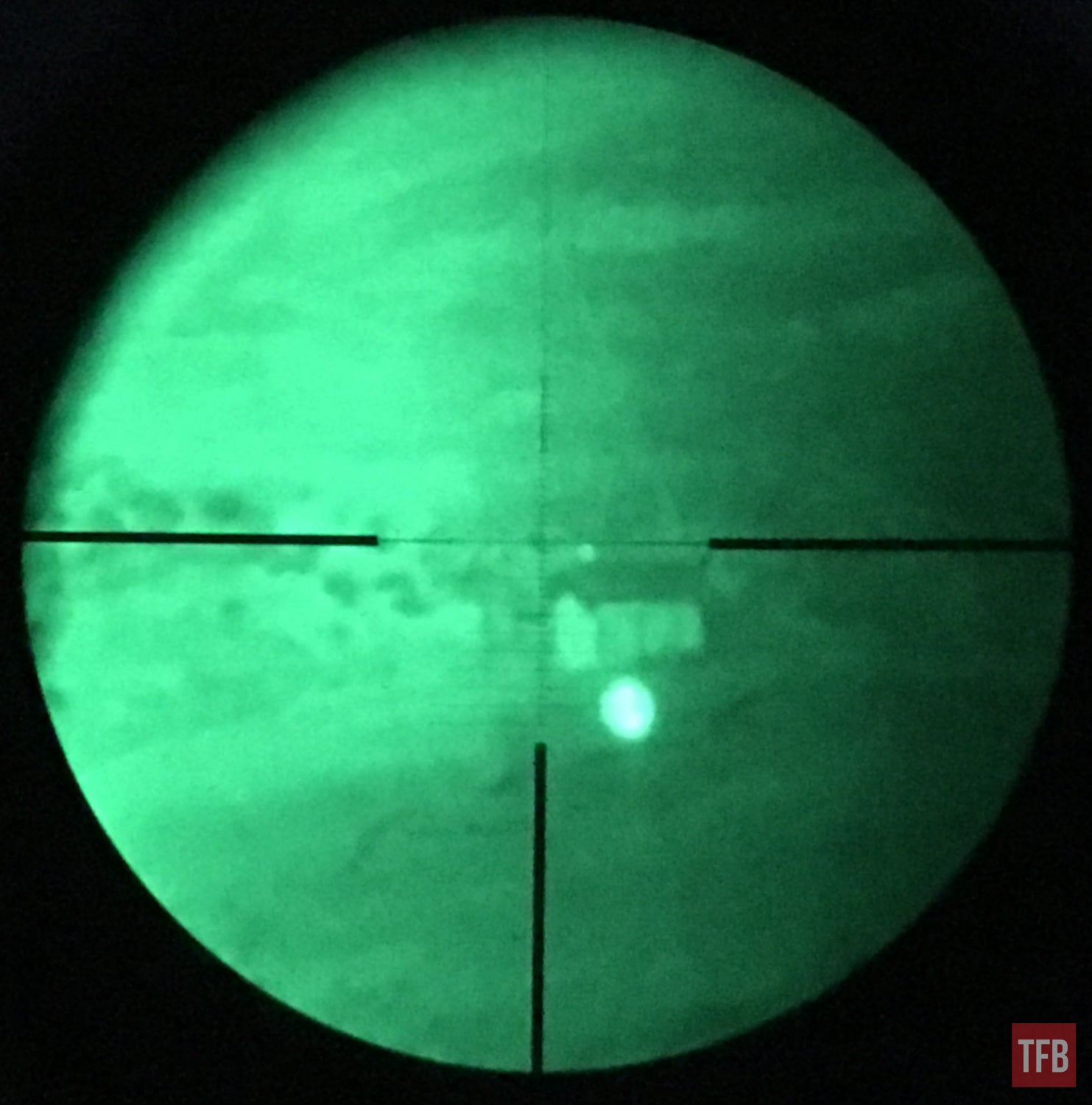
Below is a photo taken through my Bushnell LMSS with PVS-27. It was a full moon out when I took these photos. I was using the laser to reference the POA shift. You can see how the laser is zeroed to the reticle in the Bushnell LMSS. But look back at the photo above with the KN203 and Vortex scope. It is not in the same place. I have to zero the beamsplitter of the KN203 to match what the Bushnell sees.
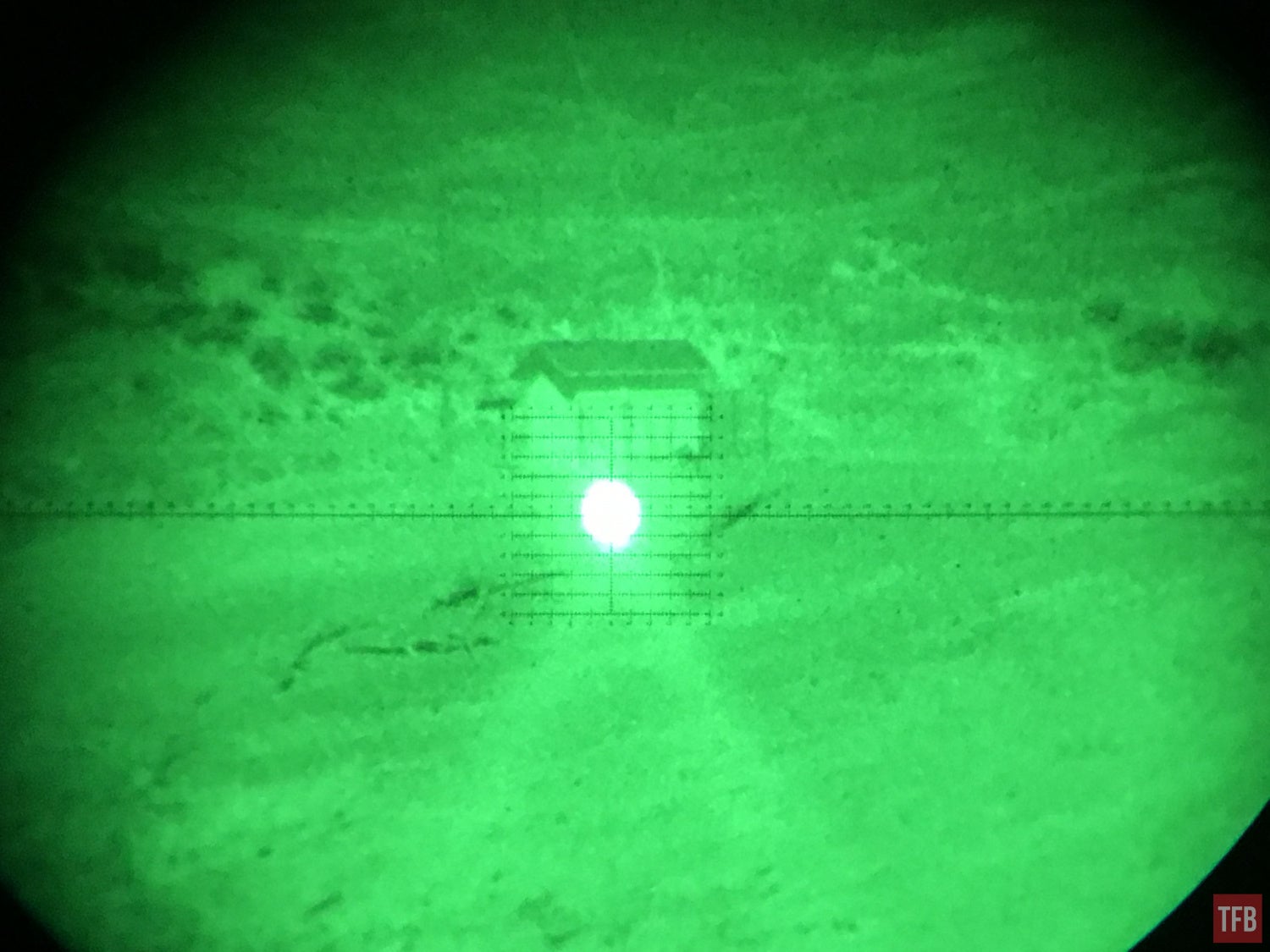
Final Thoughts On The KN203
I was a little underwhelmed by the performance however I have only seen through this particular version. I have seen online posts celebrating the performance of these clip-ons so I will chalk it up to its age and whatever image intensifier is inside it. The pale bluish green makes me think it might be a Gen 2 tube since they use similar colored phosphor in Gen 2 systems.
The price is not that bad though. You can get these used for around $2,000. Much cheaper than a PVS-27 or PVS-30. That is half the price of a refurb 27 or 30. The only major downside that I see is the limitations of the mounting system. I wanted to try this on my Leupold Mark5HD 5-25×56 but the objective bell is too long. I have seen people mention using shims from Spuhr to raise the KN203 higher to clear the objectives and mount the clip-on to the ragged edge of the mounting plate just to get them to fit. It is nice being able to mount a clip on to firearms that do not have a night vision hood or rail forward of the scope but you have 4 lbs of giant glass sitting on top of your scope. It makes the balance of the weapon a bit awkward. I think a dedicated thermal weapon sight with good starting magnification would be better and more streamlined but it depends on what you want to do with said firearm. Thermal is great for hunting but not that great for target shooting. If you want to shoot at night at a few hundred yards, it can do it. Until I see a better example, I do not know if it can help see out to 1,000 yards like the PVS-30 or PVS-27. I suspect it can with a good Gen 3 tube.
TFB’s Friday Night Lights series is brought to you by ATN
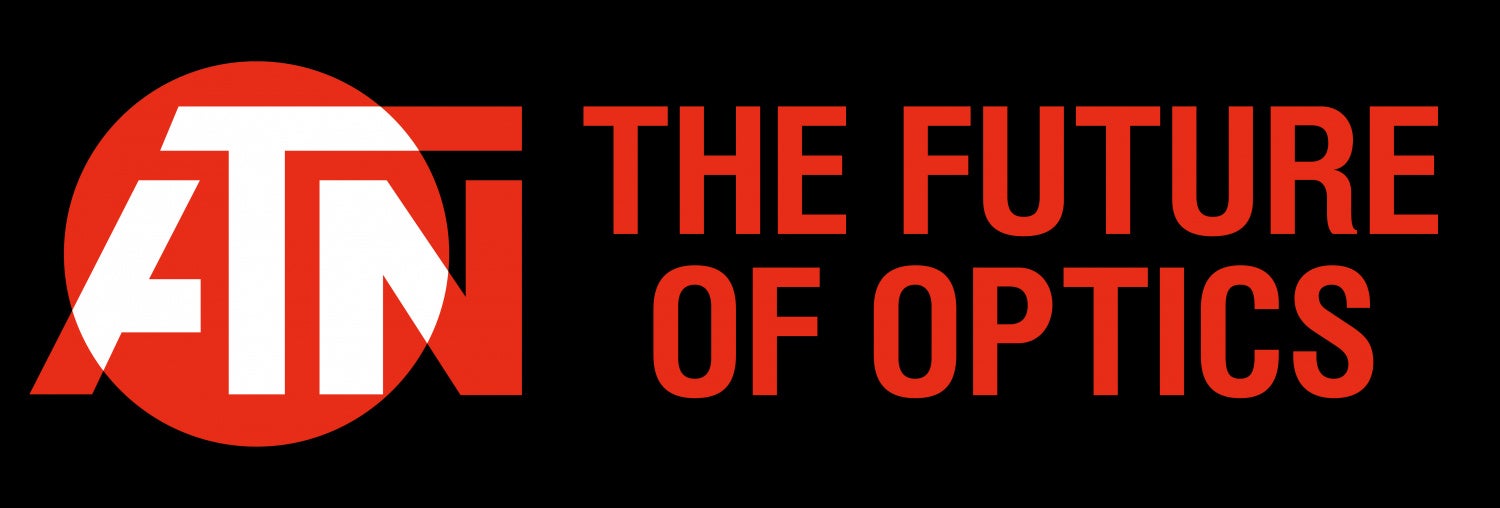
 Your Privacy Choices
Your Privacy Choices
